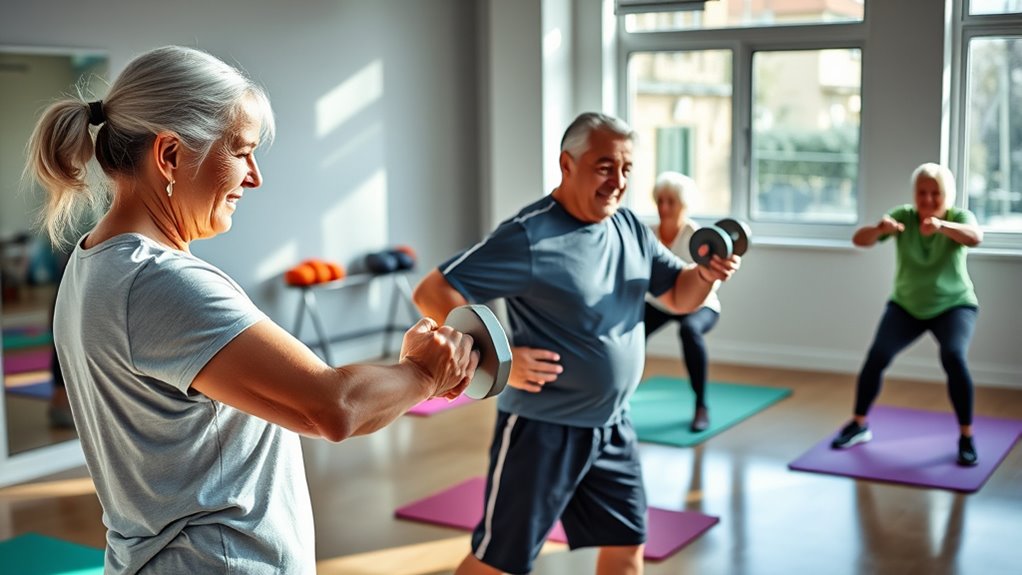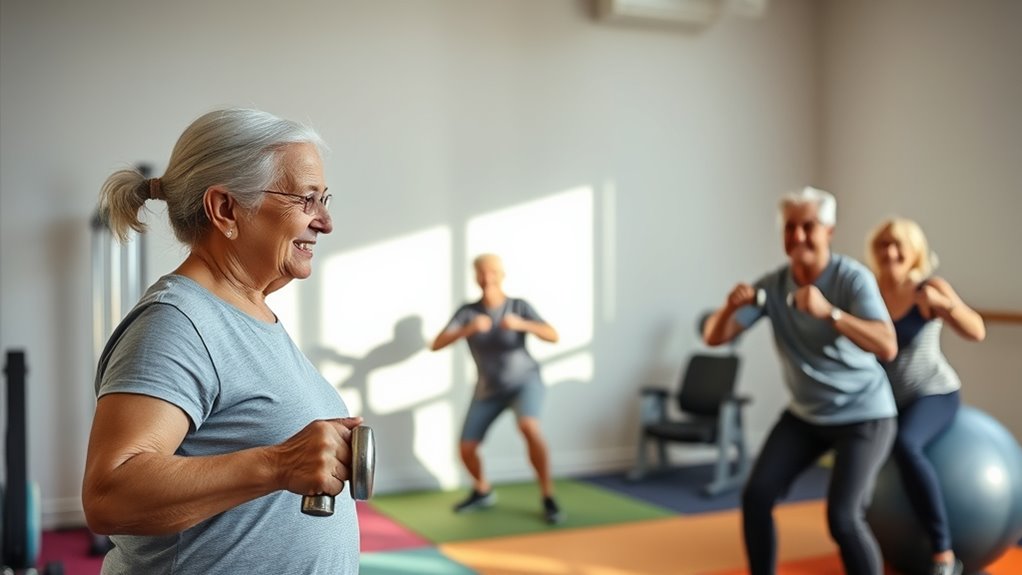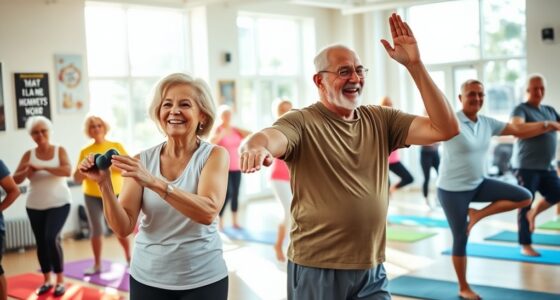Strength training exercises are essential for enhancing your strength, mobility, and independence as a senior. You can start with bodyweight exercises like squats and incline pushups to master proper form. Gradually incorporate light weights or resistance bands for added resistance. Aim for two sessions a week to improve your overall strength and reduce fall risk. With the right approach and safety tips, you can confidently strengthen your body and improve your quality of life. There’s more to explore!
Key Takeaways
- Start with bodyweight exercises like squats and incline pushups to build strength and confidence safely.
- Aim for three sets of 10 to 15 repetitions to ensure proper technique and gradual progress.
- Incorporate functional exercises like stationary lunges and seated rows to improve daily movements and balance.
- Use lighter weights or resistance bands for added safety and gradually increase as strength improves.
- Always consult a healthcare provider before beginning any strength training regimen to ensure safety.
The Importance of Strength Training for Seniors

As you age, strength training becomes vital for maintaining your mobility and independence. Engaging in regular strength training helps combat age-related muscle loss, improving your overall functional capacity. Additionally, incorporating effective relaxation techniques can help manage any stress or anxiety you may experience while exercising. Regular exercise can enhance your emotional regulation, which is essential for managing both physical and mental health as you age. By enhancing your balance and coordination, you can considerably reduce your risk of falls—up to 23%! This is essential for preventing sarcopenia, the involuntary loss of muscle mass that many older adults experience. Furthermore, strength training offers mental health benefits, such as reducing symptoms of depression and boosting cognitive function. Engaging in physical activities can foster meaningful connections that help alleviate feelings of isolation in seniors. Additionally, research indicates that foods rich in omega-3 fatty acids can support cognitive function, which is particularly beneficial as you age. Being aware of breast cancer symptoms can empower seniors to seek timely medical advice, promoting overall health vigilance. To maximize your health and wellness, aim to participate in strength training exercises at least twice a week. This commitment will help you maintain your independence in daily activities and enrich your quality of life.
Mastering the Basics of Strength Training

To master strength training, start with bodyweight exercises that help you learn proper form and build confidence. Once you feel comfortable, aim for three sets of 10 to 15 repetitions before gradually adding weights. This approach guarantees safe progress while minimizing the risk of injury. Additionally, incorporating mental resilience into your training can enhance your overall motivation and commitment to a consistent workout routine. Remember, setting savings goals for your fitness journey can be just as important as financial planning, as it helps you stay focused and committed to your health objectives. Engaging in silly tantrums during workouts can also bring a light-hearted aspect to your training sessions, making them more enjoyable. Pairing strength training with a balanced diet rich in high-protein breakfasts can further support muscle recovery and growth. Regular physical activity, like regular outings for dogs, can significantly improve your overall well-being and fitness levels.
Bodyweight Exercise Fundamentals
While many seniors may feel intimidated by the idea of strength training, mastering bodyweight exercises can provide a safe and effective entry point.
These exercises, like squats and pushups, allow you to learn proper form and technique without the risk of injury from weights. By focusing on bodyweight movements, you’ll build a foundational level of muscle strength that’s vital before progressing to weighted exercises. Moreover, engaging in strength training can enhance your cognitive development and overall well-being. Additionally, incorporating effective filtration methods in your exercise routine can help ensure a safe environment, minimizing the risk of accidents. Practicing mindfulness during your workouts can also enhance self-awareness and improve your overall exercise experience. Engaging in regular strength training can also reduce the risk of falls, which is essential for maintaining independence as you age.
Aim for three sets of 10 to 15 repetitions to enhance your muscular endurance and boost your confidence. Regular practice will greatly improve your mobility and balance, essential for preventing falls. Additionally, engaging in strength training can positively impact your hearing health, reducing the risk of age-related conditions.
As you gain strength, gradually increase the complexity of your bodyweight exercises to stay engaged and effectively challenge your muscles.
Gradual Weight Progression
Once you’ve mastered bodyweight exercises, it’s time to embrace gradual weight progression for your strength training journey.
Start with three sets of 10 to 15 repetitions to build a solid foundation without risking injury. As you gain confidence and strength, gradually increase the weight of your dumbbells or resistance bands. This guarantees you’re continuously challenged and improving at your fitness levels. Strategic planning is essential to ensure your workouts align with your overall health goals. Additionally, incorporating functional exercises can help enhance your everyday movements and overall strength. Understanding the importance of long-term financial planning is also vital for ensuring that you can sustain your fitness routine as you age.
Resistance bands are a fantastic option, offering flexibility and being budget-friendly while effectively building strength. Additionally, incorporating pet therapy benefits into your routine can enhance emotional well-being, which is crucial for maintaining motivation and consistency in your fitness journey. Engaging in mindfulness techniques can also support your emotional health during this process.
Remember, recovery is essential, especially for older adults; allow ample time between workouts to prevent soreness and maximize your results.
With patience and consistency, you’ll see significant gains in your strength and overall fitness.
Transitioning to Hand Weights

Shifting to hand weights can be a rewarding step in your strength training journey. Start with the lightest dumbbells to guarantee proper form, especially if you’re managing joint pain. Gradually increase the weight as you gain strength, but always focus on maintaining technique. Additionally, understanding alimony types can help you better manage your financial health during this transition. Consider incorporating resistance bands as a flexible, cost-effective alternative that offers similar benefits. Aim to strength train at least twice a week, allowing recovery time between sessions. If possible, seek personal training sessions to refine your form, enhancing both safety and effectiveness. Furthermore, being aware of gaslighting tactics in relationships can provide insight into maintaining emotional stability while pursuing physical health goals. Additionally, using portable equipment like resistance bands can provide versatility during your workouts. Regular exercise, including strength training, can prevent obesity and related health issues as you age. Here’s a quick reference table for your change:
| Weight Type | Benefits | Suggested Use |
|---|---|---|
| Light Dumbbells | Builds strength safely | Start with 1-5 lbs |
| Heavier Dumbbells | Increases resistance | Gradually progress |
| Resistance Bands | Versatile and gentle on joints | Great for all levels |
Additionally, understanding strong communication skills can significantly enhance your ability to seek guidance and support during your training journey.
Recommended Strength Exercises for Seniors

When it comes to strength training, there are several essential exercises designed specifically for seniors that can help you build strength and confidence. You can safely modify these movements to suit your abilities, ensuring you stay active without risking injury. Let’s explore the recommended exercises that can enhance your mobility and overall well-being. Additionally, incorporating home improvement strategies can create a safer and more supportive environment for your exercise routine. Remember that maintaining adequate hydration is crucial for optimal performance during your workouts. Engaging in regular physical activity can also improve emotional well-being and help you manage stress effectively.
Essential Strength Exercises
Incorporating strength training exercises into your routine can greatly enhance your overall health and mobility as a senior.
For older adults, essential exercises include squats, which strengthen your legs and improve your ability to rise from a seated position.
Incline pushups, performed against a wall or table, build upper body strength while being gentle on your joints.
Seated rows with resistance bands target your back muscles, enhancing posture and lifting tasks.
Stationary lunges boost leg strength and balance, vital for fall prevention.
Finally, the Dead Bug exercise focuses on core stabilization, promoting better balance and functional movement.
These exercises for older adults can make a significant difference in daily activities and overall well-being.
Safe Exercise Modifications
To safely enjoy the benefits of strength training, it’s important to make modifications that accommodate your fitness level and any physical limitations.
Here are some safe exercise modifications to keep you healthy enough while building strength:
- Squats: Lower into a chair instead of a full squat for better support and stability.
- Incline Pushups: Use a wall or table to minimize strain on your shoulders and wrists.
- Seated Rows: Perform seated rows with resistance bands to strengthen your back and improve posture safely.
- Stationary Lunges: Keep your back knee on the ground for easier execution and improved balance.
These modifications allow you to engage in strength training while ensuring your safety and comfort.
Building Confidence in Movement
Building confidence in movement is essential for seniors looking to maintain their independence and improve their quality of life.
Start with bodyweight exercises like squats and incline pushups to develop strength and learn proper form. These exercises not only enhance muscle growth but also improve mobility and reduce the risk of falls.
Incorporate seated rows and stationary lunges for a safe full-body workout that boosts self-reliance in daily activities. The Dead Bug exercise is particularly effective for engaging core stability, helping you maintain balance and prevent injuries. Aim for 10 to 15 repetitions of this exercise.
Once you feel comfortable, progress to light dumbbells or resistance bands to further enhance your confidence and effectiveness in strength training routines.
Safety Tips for Seniors Engaging in Strength Training

Before starting any strength training program, it’s essential to consult with your healthcare provider to guarantee that the exercises are safe and suitable for your individual health conditions.
Here are some important safety tips to keep in mind:
- Start with bodyweight exercises to master your form before using weights.
- Use lighter weights and resistance bands initially, gradually increasing the load as your strength improves.
- Schedule strength training sessions on non-consecutive days to allow for recovery, especially since muscle soreness may take longer to resolve as you age.
- Always pay attention to any unusual pain or discomfort during exercises, and stop immediately if you experience signs of strain or injury.
Activating Your FREE SilverSneakers Online Account

Have you activated your FREE SilverSneakers Online Account yet? If not, you’re missing out on everything you need to enhance your fitness journey.
By activating your account, you gain access to hundreds of on-demand workout videos tailored specifically for seniors, promoting safe and effective exercise options.
Plus, you’ll find instructor-led group fitness classes at various locations at no extra cost. Make sure to log in to retrieve your SilverSneakers member ID and discover nearby participating gyms and fitness locations.
Even if you’re not a member, you can still access select workout videos and health tips, ensuring everyone has a chance to stay active and informed.
Don’t wait; activate your account today and start your path to better health!
Frequently Asked Questions
What Is the Most Important Exercise for Seniors to Master?
The most important exercise for you to master is the squat. It’s a fundamental movement that builds lower body strength, enhances mobility, and improves balance, all of which are essential for daily activities like sitting and standing.
By incorporating squats into your routine, you’ll not only boost your physical capabilities but also maintain independence as you age.
Start with bodyweight squats and gradually increase intensity as you feel more comfortable and confident.
What Is the AARP #1 Exercise for Seniors?
The AARP’s #1 exercise for seniors is the Chair Stand.
It’s a simple yet effective way to boost your lower body strength and stability. To do this, sit in a sturdy chair, keep your feet shoulder-width apart, and rise to a standing position without using your hands.
Aim for 10 to 15 repetitions, two to three times a week, to enhance your mobility and reduce the risk of falls. You’ll feel more independent!
What Is the Best Strength Training for a 70 Year Old?
Think of strength training like planting a tree; you need to nurture it to see it grow.
For a 70-year-old, the best approach includes bodyweight exercises like squats and incline pushups, building a solid foundation first. Aim for two sessions a week, doing three sets of 10 to 15 reps.
Incorporating resistance bands can make workouts safer and effective, while seated rows and lunges enhance core strength and mobility, helping you stay active and balanced.
What Is the 6 12 25 Rule?
The 6-12-25 rule is a strength training guideline designed to help you improve muscle growth and endurance.
You perform 6 reps with heavier weights, 12 reps with moderate weights, and 25 reps with lighter weights. This approach allows you to gradually increase your strength while minimizing injury risk.
Conclusion
Strength training isn’t just for the young; it’s a powerful tool for seniors too. Studies show that engaging in regular strength exercises can enhance mobility, boost mood, and improve overall health. By incorporating simple techniques and hand weights, you can easily start your journey today. Remember, with the right approach and safety in mind, you can build strength and confidence in no time. So, why not activate your SilverSneakers account and explore the countless benefits waiting for you?









